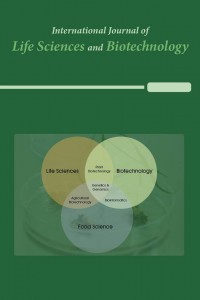Discrimination of two species (Androctonus crassicauda and Leiurus abdullahbayrami; Buthidae Scorpions) by MALDI-TOF- MS-based PCA
Discrimination of two species (Androctonus crassicauda and Leiurus abdullahbayrami; Buthidae Scorpions) by MALDI-TOF- MS-based PCA
Androctonus crassicauda, Leiurus abdullahbayrami, Scorpion Buthidae, MALDI-TOF MS-PCA analyses,
___
- [1] Rincón-Cortés, et.al., Structural and Functional Characterization of Toxic Peptides Purified from The Venom of The Colombian Scorpion Tityus Macrochirus. Toxicon, 2019. 169: p.5–11. https://doi.org/10.1016/j.toxicon.2019.07.013.
- [2] Schaffrath, S.,and Predel, R.A., Simple Protocol for Venom Peptide Barcoding in Scorpions. EuPA Open Proteomics. 2014. 3: p. 239–245. https://doi.org/10.1016/j.euprot.2014.02.017.
- [3] Oukkache, N. et.al., New Analysis of The Toxic Compounds from The Androctonus Mauretanicus Mauretanicus Scorpion Venom. Toxicon, 2008. 51: p. 835–852. https://doi.org/10.1016/j.toxicon.2007.12.012.
- [4] Yağmur, E.A, Koç, H., and Kunt ,K.B., Description of A New Species of Leiurus Ehrenberg, 1828 (Scorpiones: Buthidae) from Southеastеrn Turkey. Euscorpius, 2009: p.1–20. https://doi.org/10.18590/euscorpius.2009.vol2009.iss85.1.
- [5] Ozkan, O., and Alcigir, M.E., A Comparative Pathomorphological Findings between Leiurus abdullahbayrami and Androctonus crassicauda (Scorpion: Buthidae) envenomation in rabbit animal model. J. Arthropod. Borne Disease, 2019. 13: p. 104–115. https://doi.org/10.18502/jad.v13i1.937.
- [6] Borges, A., and Rojas-Runjaic, F.J.M., Tityus Perijanensis González-Sponga (Scorpiones, Buthidae): Molecular Assessment of Its Geographical Distribution and Venom Lethality of Venezuelan Populations. Toxicon, 2007. 50: p. 1005–1010. https://doi.org/10.1016/j.toxicon.2007.07.019.
- [7] Estrada-Gómez, S. et.al., MS/MS Analysis of Four Scorpion Venoms from Colombia: A descriptive approach. J. Venom. Anim. Toxins Incl. Tropical Disease, 2021. 27: p. 1–13. https://doi.org/10.1590/1678-9199-JVATITD-2020-0173.
- [8] Bringans, S. et.al., Proteomic analysis of the venom of Heterometrus longimanus (Asian black scorpion). Proteomics, 2008. 8: p. 1081–1096. https://doi.org/10.1002/pmic.200700948.
- [9] Numanoğlu Çevik, Y. et.al., Salih, B. Identification of Snake Venoms According to their Protein Content Using the MALDI-TOF-MS Method. Anal. Chemistry Letters, 2021. 11: p. 153–167. https://doi.org/10.1080/22297928.2021.1894974.
- [10] Martin-Eauclaire, M.F et.al., Achieving Automated Scorpion Venom Mass Fingerprinting (VMF) in The Nanogram Range. Toxicon, 2013. 69: p. 211–218. https://doi.org/10.1016/j.toxicon.2013.03.001.
- [11] Favreau, P. et.al., Mass Spectrometry Strategies for Venom Mapping and Peptide Sequencing from Crude Venoms: Case Applications with Single Arthropod Specimen. Toxicon, 2006. 47: p. 676–687. https://doi.org/10.1016/j.toxicon.2006.01.020.
- [12] Cheng, K. et.al., Recent development of mass spectrometry and proteomics applications in identification and typing of bacteria. Proteomics - Clin. Application, 2016. 10(4): p. 346-357. https://doi.org/10.1002/prca.201500086.
- [13] Taban, B.M., and Y. Numanoglu Cevik, The Efficiency of MALDI-TOF MS Method in Detecting Staphylococcus Aureus Isolated from Raw Milk and Artisanal Dairy Foods. CyTA-J. Food, 2021. 19: p. 739–750. https://doi.org/10.1080/19476337.2021.1977392.
- [14] Sauget, M., et.al., Can MALDI-TOF Mass Spectrometry Reasonably Type Bacteria? Trends Microbiology, 2017. 25: p. 447–455. https://doi.org/10.1016/j.tim.2016.12.006.
- [15] Smith, J.J, Jones, A., and Alewood, P.F., Mass Landscapes of Seven Scorpion Species: The First Analyses of Australian Species with 1,5-DAN matrix., J. Venom Research, 2012. 3: p. 7–14.
- [16] Schaffrath, S. and Predel, R., A Simple Protocol for Venom Peptide Barcoding in Scorpions. EuPA Open Proteomics, 2014. 3: p. 239–245. https://doi.org/10.1016/j.euprot.2014.02.017.
- [17] Jeong, Y.S., Lee, J., and Kim, S.J. Discrimination of Bacillus Anthracis Spores by Direct in-situ Analysis of Matrix-Assisted Laser Desorption/İonization Time-of-Flight Mass Spectrometry, Bull. Korean Chemical Society, 2013. 34: p. 2635–2639. https://doi.org/10.5012/bkcs.2013.34.9.2635.
- [18] Samad, R.A, and Al Disi, Z., The Use of Principle Component Analysis and MALDI-TOF MS for The Differentiation of Mineral-Forming Virgibacillus and Bacillus Species Isolated from Sabkhas. R. Soc. Chemistry, 2020. 10: p. 14606–14616. https://doi.org/10.1039/d0ra01229g.
- [19] Romi-Lebrun, R. et.al., Characterization of Four Toxins from Buthus Martensi Scorpion Venom, Which Act on Apamin-Sensitive Ca2+-Activated K+ Channels. Eur. J. Biochemistry, 1997. 245: p. 457–64. https://doi.org/10.1111/j.1432-1033.1997.00457.x.
- [20] Caliskan, F. et.al., Characterization of Venom Components from The Scorpion Androctonus Crassicauda of Turkey: Peptides and genes. Toxicon, 2006. 48: p. 12–22. https://doi.org/10.1016/j.toxicon.2006.04.003.
- Yayın Aralığı: Yılda 3 Sayı
- Başlangıç: 2018
- Yayıncı: International Society of Academicians
Arif PARMAKSIZ, Aynur DEMİR, Dilara ULUSAL
Leyla GÜVEN, Ufuk ÖZGEN, Handan SEVİNDİK, İclal AĞAN, Mehmet KOCA, İbrahim TURAN, Selim DEMİR, Yüksel ALİYAZICIOĞLU
SARS-CoV-2 Spike Protein Reseptör Bağlanma Bölgesinde L18F Mutasyonunun Homoloji Modellemesi
Gizem KÖPRÜLÜLÜ KÜÇÜK, Nazlı Irmak GİRİTLİOĞLU
Karbon noktaların tarımsal üretimde kullanılması
Mehmet Han BAŞTÜRK, Şahane Funda ARSLANOĞLU, Rumeysa ÖZTÜRK
Abdullahi AJAO, Ganiyat ALASİNRİN
Yasemin NUMANOĞLU ÇEVİK, Mehmet Ali KANAT
Saloa SANJİDA, Moslema Jahan MOU, Sk Injamamul ISLAM, Md. SAROWER-E-MAHFUJ
İşlenmiş gıdalar için GDO tespitinde modifiye DNA izolasyon yöntemlerinin karşılaştırılması
